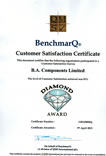- Home
- Tube Fittings by Sector
- Tube Fittings by Type
- BAC-LOK Assembly
- Assembly Instructions
- Male Connectors
- Male Elbows
- Male Run Tees
- Male Branch Tees
- Bulkhead Connectors
- Female Elbows
- Female Run Tees
- Female Branch Tees
- Equal Unions
- Unequal Unions
- Bulkhead Unions
- Union Elbows
- Female Connectors
- Union Tees
- Equal Unions Crosses
- Plugs
- Caps
- Male Adaptors
- Female Adaptors
- Reducers
- Bulkhead Adaptors
- Nuts
- Ferrules
- Lock Nuts
- Tubing Data
- Pipe Fittings
- Hose Fittings
- Contact Us
TUBING DATA
The following variables should be considered when ordering tubing for use with BAC-LOK tube fittings.
- Material
- Wall Thickness
- Surface
- Finish Hardness
- Tube Hardness
The key to proper tubing hardness for use with BAC-LOK tube fittings is that the tubing must be softer than the fitting material. BAC-LOK stainless steel fittings have been repeatedly tested successfully with tube having a hardness of up to Rb90, the maximum hardness allowable under ASTM A213 and A269. Although such hardness is permissible, it is recommended that wherever possible a hardness of Rb80 maximum is specified when ordering tubing. Such tubing lowers the installed cost as it is more easily bent and installed. Tubing installers should be particularly careful when installing harder tubing, to be sure that the full recommended 1-1/4turns of pull up are used. As higher torques are required on harder tube,there may be tendency to stop before pull up is achieved. The Rb80 is a recommendation, not a restriction against the use of BAC-LOK stainless steel tube fittings.
Gas Service
Light gases such as helium, hydrogen, nitrogen etc. have very small molecules which can escape through the even the most minute leak path. Some surface defects on the tubing can provide such a leak path. As tube O.D. increases, so does the likelihood of a scratch or other surface defect interfering with proper sealing.
The most successful connections for gas service will occur if all installation instructions are carefully followed, and the heavier wall thickness of tubing are selected.
A heavy wall tube resists ferrule action more than a thin wall tube, allowing the ferrules to coin out minor surface imperfections. A thin wall tube will collapse, thus offering little resistance to ferrule action during pull-up. This reduces the chance of coining out surface defects, such as scratches. For the greatest safety factor against surface defects in any gas system, use a wall thickness no less than the following.
| Tube O.D. (Metric mm) | Suggested min wall | Tube O.D. (Imperial-in) |
Tube O.D. (Imperial-in) |
| 3mm | 0.7 | 1/8 | 028" |
| 4mm | 0.7 | 3/16 | .028" |
| 6mm | 0.7 | 1/4 | .028" |
| 8mm | 1.0 | 5/16 | .035" |
| 10mm | 1.0 | 3/8 | .035" |
| 12mm | 1.0 | 1/2 | .035" |
| 16mm | 1.2 | 5/8 | .065" |
| 18mm | 1.2 | 3/4 | .065" |
| 20mm | 1.5 | 7/8 | .083" |
| 22mm | 1.9 | 1 | .083" |
| 25mm | 2.0 |



